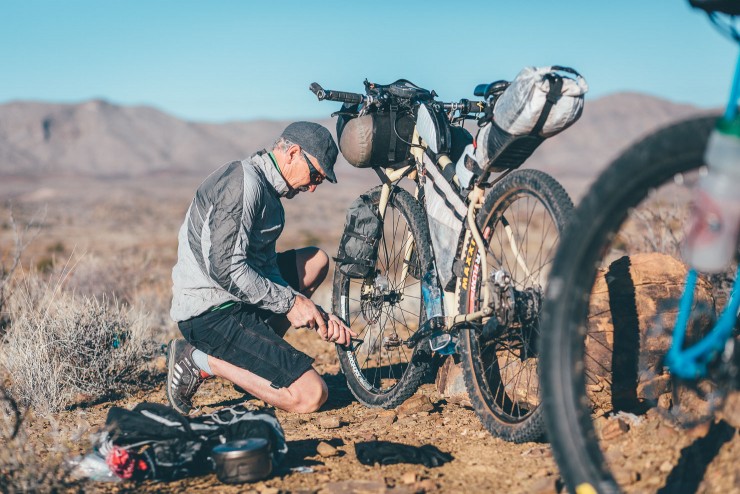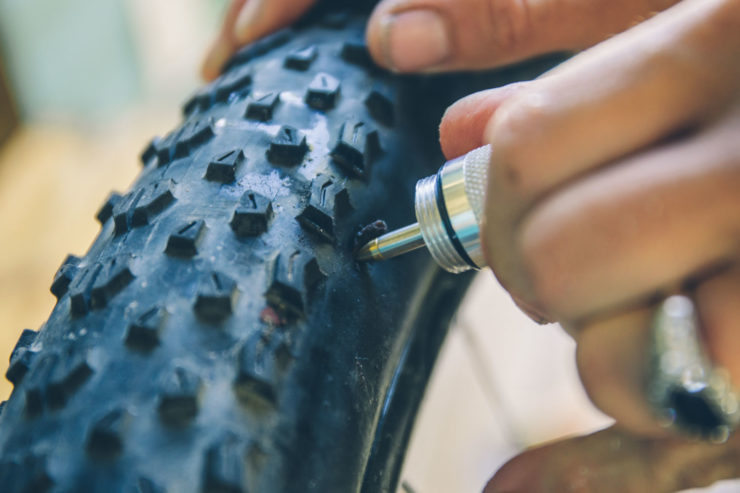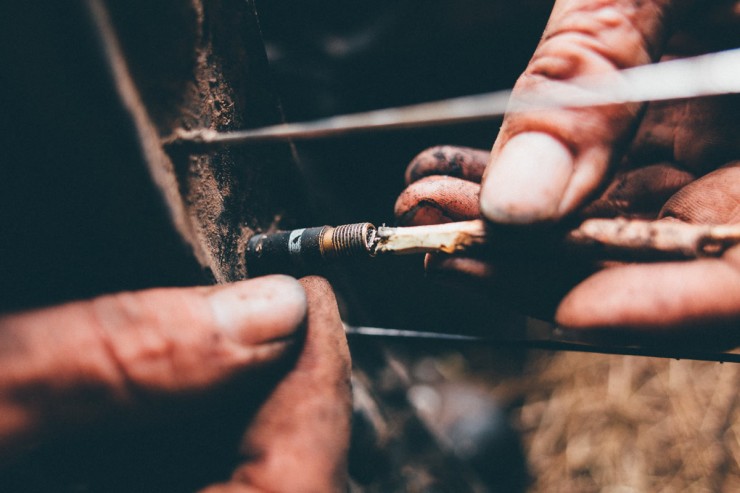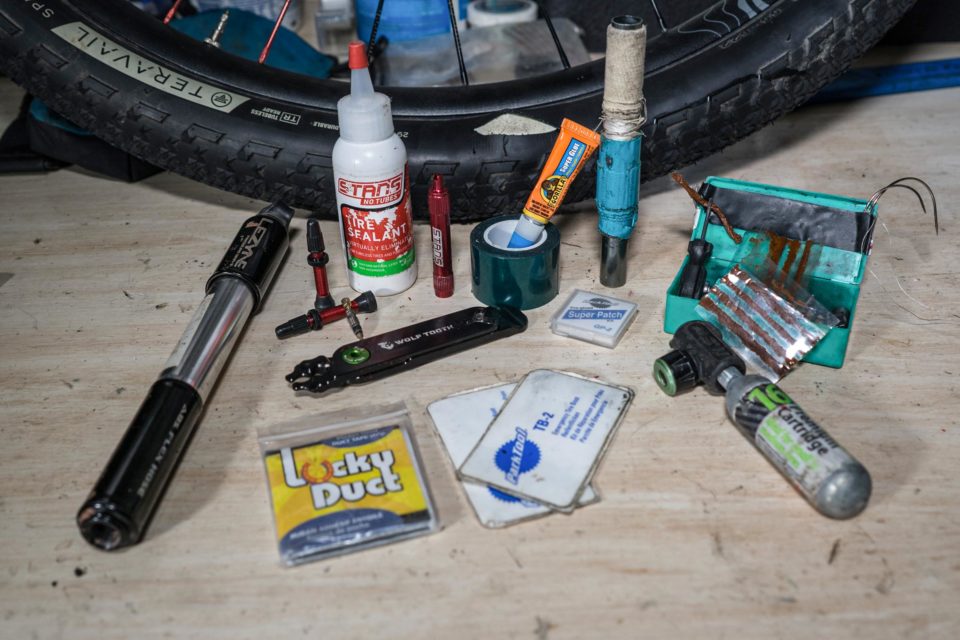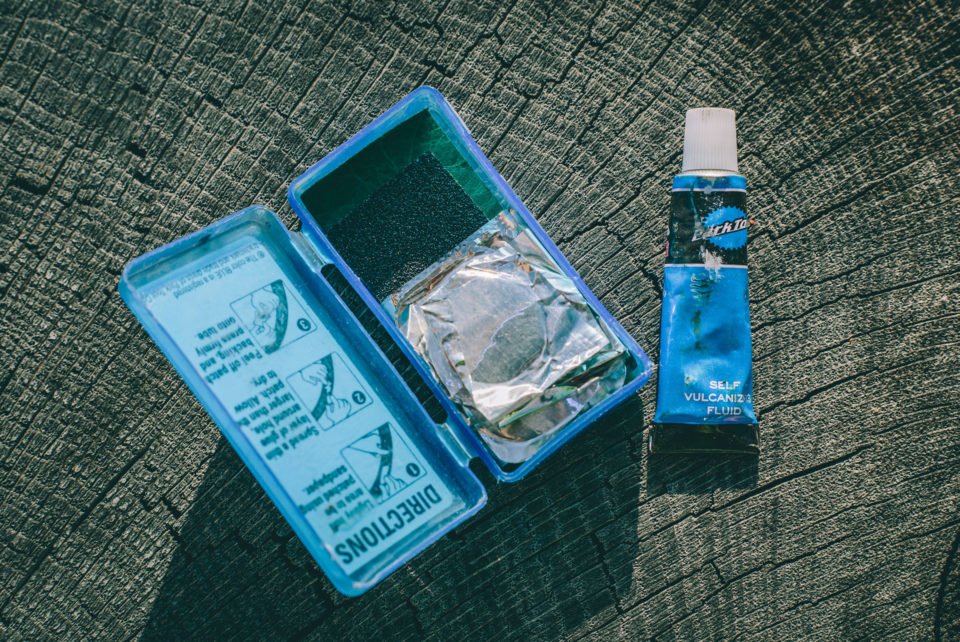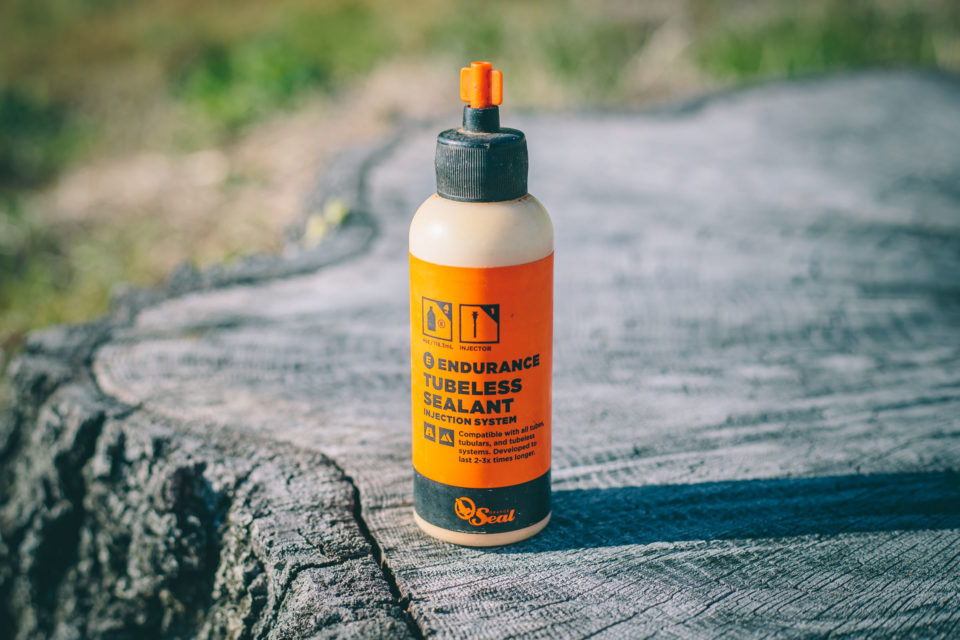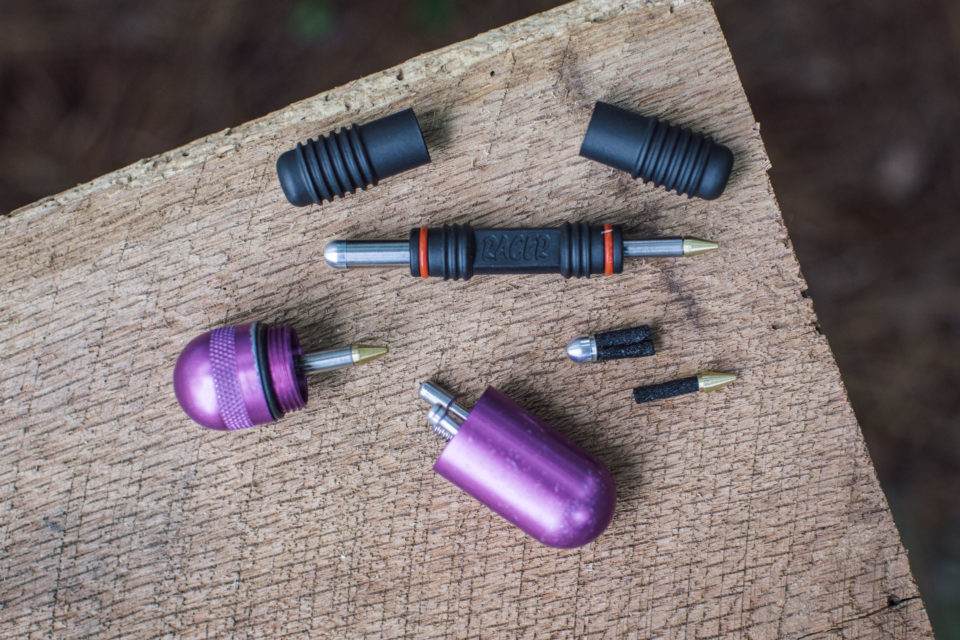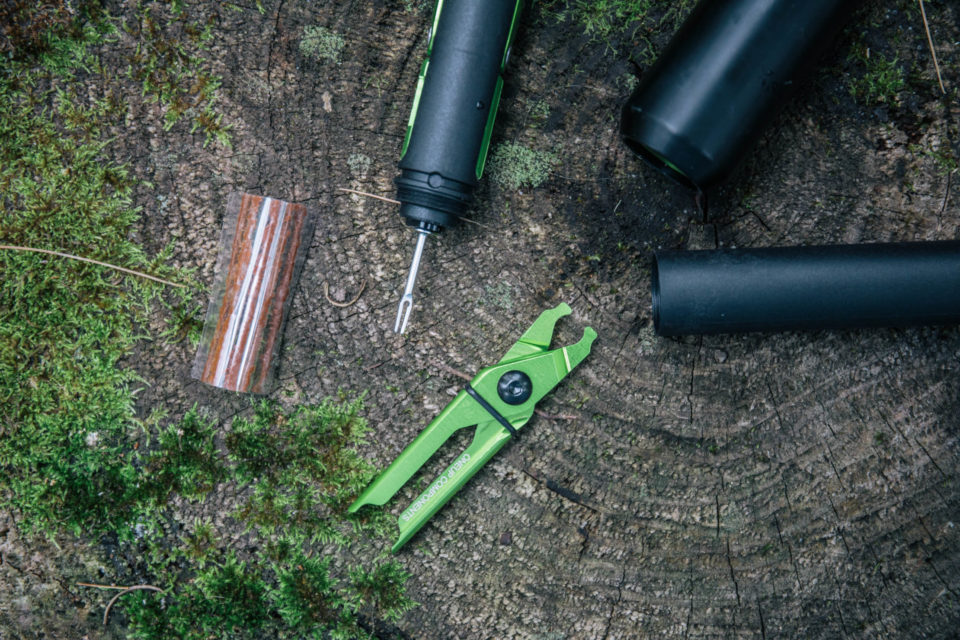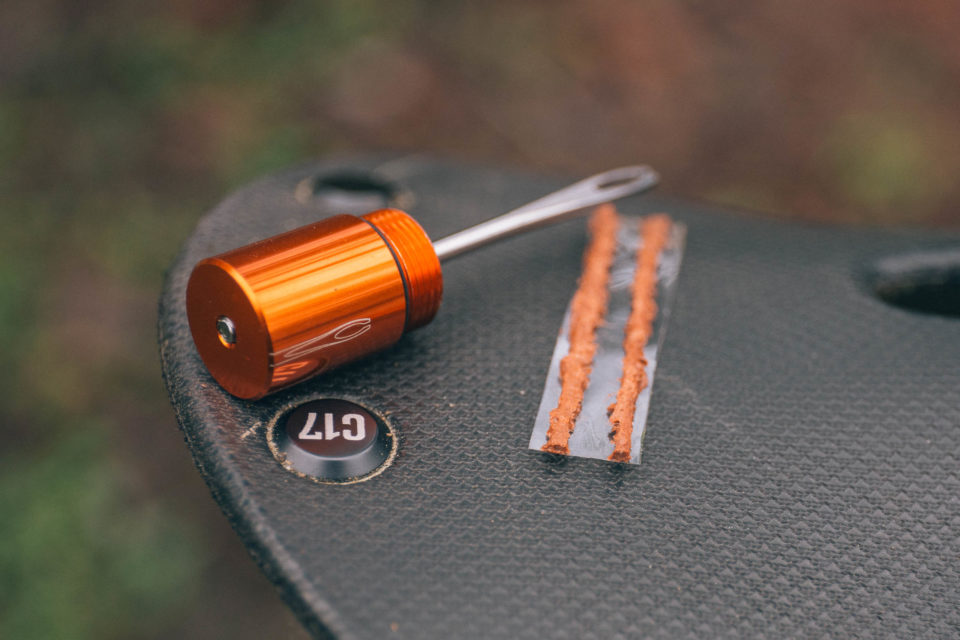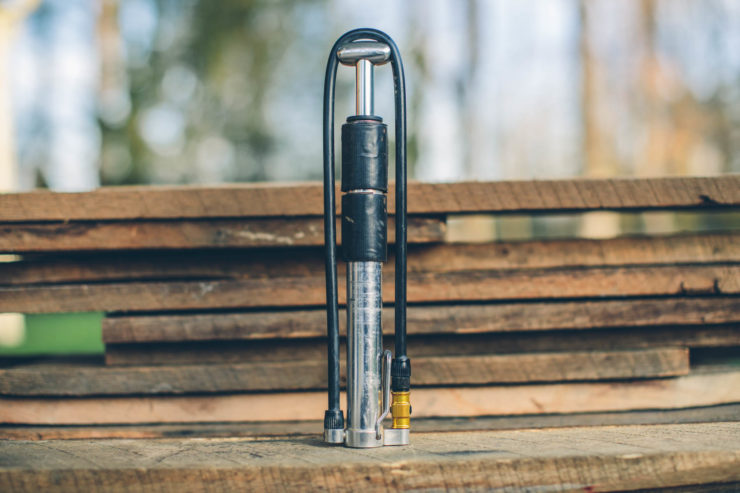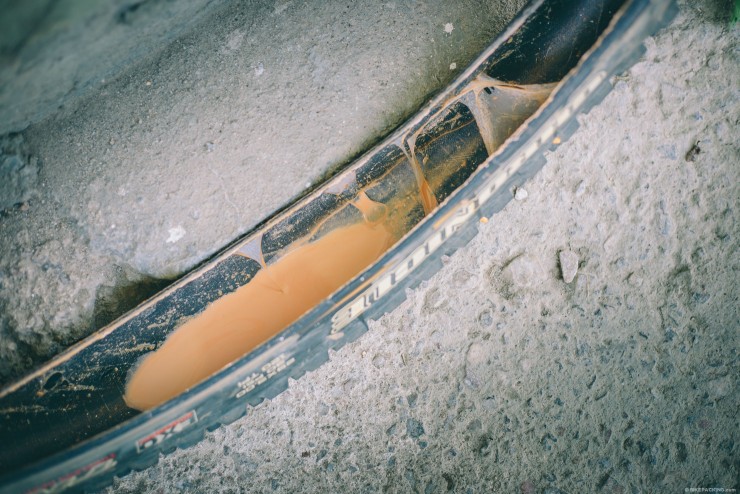Field Guide to Tubeless Tire Repair and Setup
Share This
Considering a tubeless tire setup for a long international trip? Or just hoping to have flatless bikepacking outings in your own backyard? Here’s our complete field guide to tubeless with a full tubeless tire repair kit, how-to videos for repair and setup, plugger options, and tips from the road…
Despite the fact that most of the mainstream mountain bike world has converted, many bikepackers and bike tourers remain cautiously hesitant to transition to a tubeless setup, especially for big long-distance trips. We get it. For folks who haven’t performed their own tubeless conversion, it can seem like a daunting task. To some, it remains a dark art… or at least, a complicated operation that requires special skills, a compressor, and general mechanical savvy to successfully complete.
Table of Contents
Tubeless Tire Setup
Tubeless Tire Repair
Tubeless Tire Repair Kit
Pluggers
Tips for Traveling Tubeless
But we’ve put this guide together in hopes of convincing you otherwise. In our opinion, tubes have long been dead. Just go for a long dirt road tour in South Africa. Or spend a few days out on the Arizona Trail. Or bomb down a rocky trail in backcountry Peru. Never having flats rules… period. Combined with the ability to run lower tire pressures for a more compliant ride—especially given the popularity of larger volume tires and wider rims these days—we think everyone should be running tubeless tires at this point. Not only are most rims and tires now optimized for tubeless, many new bikes are ready to convert, or are already tubeless out of the box. In addition, there’s a multitude of great tubeless repair tools and pluggers on the market, making repairs easy once you have the basics down.
To help demystify the whole process, here’s our full field guide with videos, tips, tricks, and a full tubeless repair kit to get you started and keep you rolling. We encourage you to give it a try; experience is more valuable than anything. Further down the post, you’ll also find two full video guides that we put together. But first, some basics on tires and rims.
Tubeless Rims
Although most modern rims are “tubeless ready” these days, there are still new bikes that get specced rims that are not. The most prevalent feature on a tubeless ready rim is that the rim bed features bead-locks, or small ridges in the flat section of the rim profile that help prevent burping (when the bead momentarily breaks and air is burped out). Meanwhile, a properly designed center channel makes a loosely mounted tire “grab” air and snap over the bead locks. The latter is the key to their ease of tubeless tire installation.
Tubeless Ready Tires
Although you can often use standard tires for a tubeless setup, a tubeless ready (TR) model will likely seal better due to its optimized bead design. You’ll appreciate this all the more when installation conditions aren’t optimal. TR tires also tend to have reinforced sidewalls; given that a tubeless tire is run at lower pressures and can be more susceptible to sidewall cuts, this is especially welcome. If TR models aren’t available to you, we prefer tires with lower TPI counts for long-distance travel.
Tubeless Tire Setup
Setting up your wheels and tires tubeless isn’t as difficult as you might think. Watch our video setup guide below, along with some tubeless setup tips. Also, scroll to the bottom of the page to find our step-by-step guide to setting up tires tubeless before and after flying with your bike.
Proper Tubeless Tape Job
Properly taping the rim is crucial to a successful tubeless setup. Start by cleaning the inside of the rim. Use rubbing alcohol or a degreaser to get any residue or factory finish off the rim. This ensures that the tape will stick. Use the widest tape possible to fit in the face of the rim. As for brands, WTB TCS tape works well and comes in several widths. With the disc rotor facing you, tape the rim in a clockwise rotation, which allows the force of the tire sealant liquid to not agitate the tape seam (the clockwise rotation of the wheel will generally allow the liquid to flow over the seal and not against it). Start the tape on the face opposite the valve stem hole and allow a 1” to 2″ overlap. After taping, carefully cut a smooth hole for the valve stem using a sharp blade.
Use Tubes First
For a tubeless tape job that lasts, we highly recommend mounting the tire with a tube inside before setting it up with tubeless sealant. Doing so ensures that the tape fully seals to the rim and keeps sealant from penetrating under the tape and causing it to peel up over time. Inflate the tube to the typical maximum pressure recommended for your tires and let it sit overnight. The next day, unseat one side of the tire and remove the tube. This helps the tire create the “memory” of its shape, which aids in the initial setup. Here’s a nice and clear how-to video from WTB for reference.
Tubeless Repair
Here’s our full video guide to tubeless tire repair. Watch it, then scroll down to find important tips, tools, and other information.
Know how to repair a sidewall
This is a useful skill to acquire, given that some tubeless tires are more prone to sidewall failures than regular ones. This is especially important when planning a desert adventure, where jumbles of razor-sharp rocks often abound. Tire plugs will repair most cuts; use them with the tool provided to blot a tire wound. To fix larger cuts without unseating the tire, carry a heavy, curved needle and a length of dental floss to sew the cut up first. A dab of superglue over the dental floss is recommended. For longer, 2” to 3” gashes, add a section of sidewall cut out from an old tire, using Shoe Goo (REI sells small containers) to glue in the boot after sewing the cut. Let the glue dry overnight with an inflated tube in place to hold pressure on it–it’s rare to have a cut so bad that you can’t wait till night to do this. If your repair won’t hold, make sure you have a couple of inner tubes on hand. Just be sure to remove all the thorns from the casing before you fit it!
Baby your spare tube(s)
Although one tube is often enough, we’d always recommend carrying at least two spare inner tubes when heading overseas, especially if you’re running an unconventional tire size. Generally speaking, your spare tubes can be ultralight models, as it’s unlikely they’ll be needed. Just make sure you baby them! It’s easy to leave them languishing in the bottom of a frame bag, where they’re prone to abrasion. We wrap one in tape and attach it to the bike, and store another in a thin sock for protection. Some use a ziploc bag with baby powder, as legend has it a little talc allows the tube to move inside the tire, and may help eliminate pinch flats from twisted during installation. If and when they’re needed, be sure to check your tire thoroughly first. Most likely, it will be riddled with thorns or other debris. In a pinch, you can always run conventional 26” tubes on a 29er, or even a fat bike.
Tubeless Tire Repair Kit
We’ve posted a full-blown bikepacking repair kit in the past, but here’s the tire repair kit of the future. Start by thinking less about tubes and more about repairing your tires and keeping them sealed.
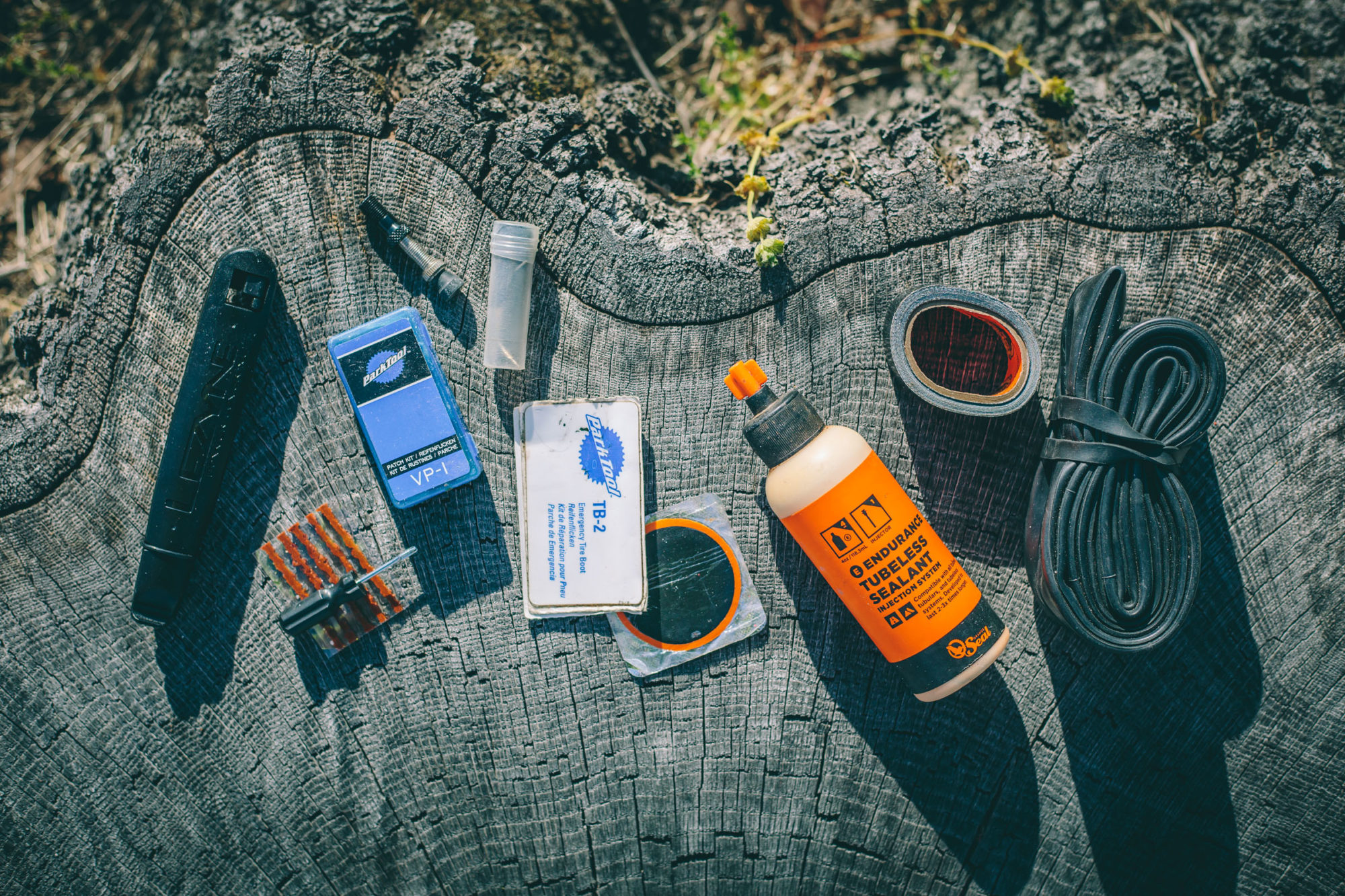
Tire Sealant
Although this may vary depending on tire volume, we recommend carrying 2oz of sealant for small day rides or overnighters, at least 4oz of sealant for trips up to a few weeks, or for extra long trips, make it 8oz. Orange Seal comes in handy 4oz injector bottles. Orange Seal Endurance is a favorite for several of us here.
Tube(s)
Always carry at least one tube. To be ultra safe or for longer trips, carry two. And as mentioned above, be sure to take extra care of it by storing it in a Ziploc bag.
Gorilla Tape
Roll a dozen or so winds around your pump. Gorilla tape can be used to help with a tire tear or to re-tape a rim, in addition to a ton of other miscellaneous uses around camp.
Patch Kit
Carrying a patch kit is a must. In the event of having to use a tube, you’ll likely need to patch it down the road, particularly if you are traveling through desert landscapes where thorns or goatherds are prevalent. Pro tip: make sure the cement isn’t dried out and the sandpaper is in good shape. Also, alongside a tube, we’ve used patches to seal small sidewall cuts, much like a tire boot.
Super Glue or Shoe Glue
Super glue or shoe glue can help aid in the repair of a tire tear in the tread area or sidewall. You can even put glue around a plug for additional support, or on the adhesive side of tape and create an ultra strong bond.
Spare Valve
It’s easy to damage a valve, have one clog up, or even loose the core while working on a trailside repair. So, carry an extra. They’re small enough.
Tubeless Plugs
These work well for punctures that are too big for the sealant but not so big you need a boot. It should provide a permanent repair for most normal punctures. Find a full list of plugger options below. Also note that if you are out of plugs, you can wedge in bits of cloth, rope, or other sealant absorbing materials to stop a leak. This can be especially handy if the hole is larger.
Curved Needle and Thread
A heavy duty curved upholstery needle and nylon thread are useful for fixing larger cuts without unseating the tire. You can also use this to repair a bikepacking bag, if need be. This looks like a suitable option.
Piece of old tire sidewall
For 2-3″ gashes, this can be glued into place.
Valve Core Tool and/or Leatherman
Although a dedicated valve core removal tool is best, the pliers on a Leatherman work. However, you might risk messing up the threads if you use a pump with a threaded head. The spoke wrench on your multitool may work to remove valve cores, too. If you lose your valve core tool… whittle one from wood! (see photo)
High Volume Pump
Last but not least, a good pump is a must. One of our favorites is the 100cc OneUp EDC pump ($59). Also, the Lezyne Micro Floor Drive HV ($65 with gauge) has proven useful and durable. The latter is a bit more powerful, but the screw-on head can be a little annoying, causing the unexpected removal of the core when unscrewing it from the valve. And if you’d rather not have a larger pump, you can also make your own tubeless tire inflator.

Tire Pluggers
With a proper tubeless setup, and generally tough tires, it’s not often that you have to resort to tire plugs. However, they’re an indispensable part of a proper bikepacking repair kit. And since tubeless tires have become ubiquitous with modern mountain bikes, there’s a wealth of tire pluggers on the market. Most are based around the classic tiny screwdriver-esque mini-plugger that’s used to insert small sticky plugs, aka bacon strips. These integrate a similar tonged metal fork into another tool, case, or handle. For most of these types of pluggers you can buy the plugs separately. Others, such as the Dynaplug, or Stan’s Dart, use proprietary plugs. Find a list of some of the more popular options below. Note that there are a few affiliate links here. We prefer that you buy from and support your local bike shop, but if you must buy online, we get a very small kickback if you purchase via these links.
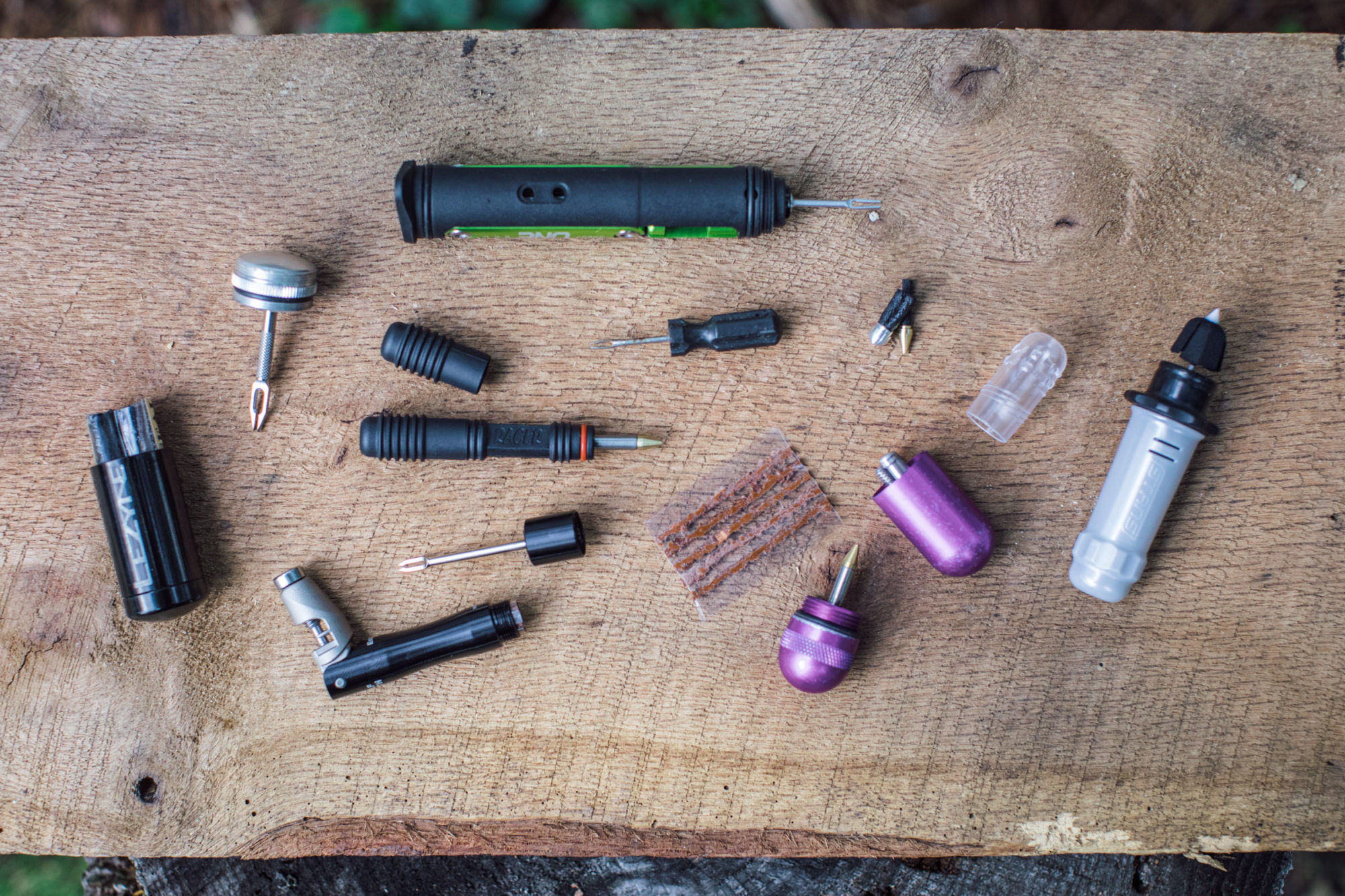
Genuine Innovations Tubeless Repair Tool
The Genuine Innovations Tubeless Tire Repair Kit is the most basic and inexpensive plugger on the market. For just over $6, you get the miniature screwdriver-like plugger tool and “Side of Bacon” (five rope repair plugs). It works, it’s cheap, and it’s fairly easy to use. $6.38 on Amazon.
Dynaplug
The Dynaplug Micro Pro tubeless repair kit is designed to be a quick and easy puncture tool. The crux of the patented system is a two-piece aluminum body with a hollow stainless steel insertion tube that’s threaded into the handle. The tube is preloaded with a repair plug where it sits in place, ready for action. The repair plugs are each made of a proprietary rubber-impregnated cord mounted to a pointed, non-abrasive brass tip. The other side of the “pill” features a honeycomb of tools, including an awl for clearing the hole and a small knife for cutting off excess plug material. We’ve used one quite a bit and they are certainly the most user-friendly plugger we’ve ever used. Read our review here or pick one up at Dynaplug’s Amazon store for $59. Dynaplug also makes the Racer, shown above, with the larger blunt-end plug for bigger tears on one side and the smaller plug on the other. $49 on Amazon.
Wolf Tooth EnCase Bar Kit One
The Wolf Tooth Encase Bar Kit One is a handy toolkit that stashes in your bar ends. One side has a multi-tool and the other has a chain breaker and a threaded cap that reveals a tubeless tire plugger, as well as a hollow chamber containing a five-pack of small tubeless plugs. It works similarly to a standard miniature plugger tool and uses the same plugs. Read our review here. You can find the Bar Kit One at some bike shops or buy one online for $120.
OneUp EDC Pump
Similar to the Wolf Tooth Encase, OneUp’s EDC Pump and Tool has a small cylinder with a threaded cap. On the inside of the cap is a tubeless repair tool and the cylinder has enough room to store a dozen plugs. The EDC Pump is one of the best we’ve used and having the tool and tubeless repair kit all inside makes it a no-brainer for day rides or bike trips. Read our review here. The full EDC system isn’t cheap. You have to buy three different components: the pump for $59, the Tool for $59, and the Plug and Pliers Kit for $39. But, we’ve been using one regularly for several years and have zero complaints.
Lezyne (Oversized Tire Plugger)
The Lezyne tubeless repair kit features an oversized repair fork and oversized plugs. These are double the size of typical tubeless plugs, so certainly better for larger holes and tears. Lezyne plugger retails for $19.99.
Granite Designs Stash Tool
As part of Granite Designs’ Stash Tool line, the Stash Tire Plug uses an expandable rubber plug and aluminum cap to tuck away in the end of your handlebar. An aluminum sleeve houses a fork-style applicator, reamer, and four tire plugs, providing a sleek and easily accessible home for all of your tire plugging needs. Read our review here.
Stan’s Dart Tubeless Repair Tool
While other pluggers, such as the Dynaplug or typical “bacon strips,” are designed to wedge sticky rubber strips into a puncture, the DART’s plugs feature a hackle of specially designed material that’s engineered to create a chemical reaction with Stan’s sealant to quickly form a permanent airtight bond. We’ve yet to try the Dart, but will update this if we do. The Dart retails for $25.
Sahmurai Sword
The Sahmurai Sword (named after the creator Stefan ‘Sahmurai’ Sahm) uses a unique twist-to-lock design, replacing your bar end plugs with two impact-resistant rubber tools: one reamer and one fork-style applicator. The plug itself is held by the applicator within the bar, which means extra plugs must be carried elsewhere. Learn more over at Sahmurai.com.
Tips for Traveling Tubeless
One roadblock to tubeless for a lot of people is traveling with your bike—particularly travel that involves flying. For the most part, you can set your bike up tubeless beforehand, and simply add a little extra sealant and inflate your tires upon landing. Away from the comforts of your workshop or local bike shop, this might seem challenging, but with the right rims and tires, and a little preparation, it’s actually pretty easy. Here are a few tips we’ve learned over the years.
Put Several Rides on Your Tires
It’s never a good idea to start a big bikepacking trip on fresh tires, regardless. Tires can sometimes have defects, so giving them a proper test beforehand is always a good idea. This also ensures a proper tubeless seal. Four or five good rides can help get the sealant in all the right places.
Use minimal sealant and pack extra
For trips that require travel, one method we’ve used in the past is to be conservative with the amount of sealant you use initially. This isn’t necessary, but it saves a mess if your tire seals break in transit. If you choose to go this route, bring extra sealant to add to it once you arrive at your destination. As an example, for two 29+ bikes, we found that one 16oz bottle of Orange Seal, one 4oz injector kit, and a spare empty 4oz bottle did the trick for adding sealant upon arrival and ensuring enough backup sealant for a two-month trip.
Pack it properly
If you’re flying with your bike, let most of the air out of the tires, as required by most airlines. Be sure not to completely deflate the tire though, to protect your rims, and minimise the chance of the bead unseating. When you box your bike, rotate the wheels to make sure the wheels are rotated so that the valves are at the top—this will prevent sealant from settling in the valve and clogging the core.
If the seals get broken
If your bead seals get broken in transit, you’ll have to repeat the set up procedure from the comfort of your hostel or hotel. Inflate with a mini pump (as mentioned above, we highly recommend a high volume pump like the 100cc OneUp EDC, or Lezyne’s Micro-Floor Drive HV). If you’re having a hard time getting the bead to push into place while pumping vigorously, try working the bead against the bead-lock lip. Sometimes it helps to have a friend hold the wheel off the ground, while an extra pair of hands can also help move the bead toward the rim while you’re pumping. If such hands aren’t available, we’ve also found that two Surly Junk Straps to cinch the tire into place can really help. Failing this, a trip down a local mechanic with a compressor should do the trick. When the tire is inflated, check that it’s seated evenly. Extra pressure will generally encourage it to snap into place. If not, deflate, moisten the bead with soapy water, and try again.
Have any tubeless repair tips or tricks to share? Or stories from the road? Leave us a comment below…
Please keep the conversation civil, constructive, and inclusive, or your comment will be removed.












